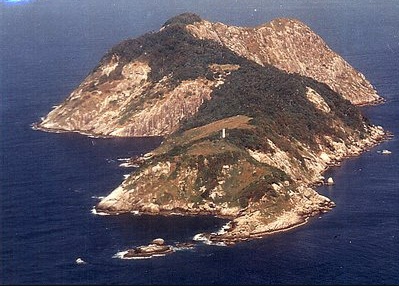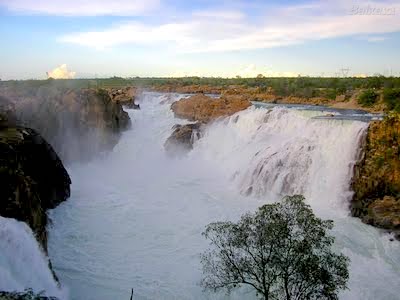|
Cagarras Islands
The Ilhas Cagarras (Cagarras Islands) are an uninhabited archipelago located off Ipanema, a major beach of the southern coast of the city of Rio de Janeiro, Brazil. They have been designated a federal natural monument since 2010. Location The archipelago is in the municipality of Rio de Janeiro, in the state of Rio de Janeiro. It has an area of . It is an important area for fisheries and tourism, and is subjected to upwelling of cold waters during summer. The water quality is relatively poor due to its close proximity with Rio's city waste water disposal. The islands are nonetheless frequented by day excursions of eco-tourists. The archipelago consists of the following islands ("ilha" in Portuguese means island, "ilhota" = islet): * Ilha Cagarra * Ilha de Palmas * Ilha Comprida * Ilha Filhote * Ilhota Grande * Laje de Cagarra The first three are the largest. Ilha Cagarra, the island group's namesake, is the tallest (79m/259 ft.) and most visible from land. Although the isl ... [...More Info...] [...Related Items...] OR: [Wikipedia] [Google] [Baidu] |
Rio De Janeiro
Rio de Janeiro ( , , ; literally 'River of January'), or simply Rio, is the capital of the state of the same name, Brazil's third-most populous state, and the second-most populous city in Brazil, after São Paulo. Listed by the GaWC as a beta global city, Rio de Janeiro is the sixth-most populous city in the Americas. Part of the city has been designated as a World Heritage Site, named "Rio de Janeiro: Carioca Landscapes between the Mountain and the Sea", on 1 July 2012 as a Cultural Landscape. Founded in 1565 by the Portuguese, the city was initially the seat of the Captaincy of Rio de Janeiro, a domain of the Portuguese Empire. In 1763, it became the capital of the State of Brazil, a state of the Portuguese Empire. In 1808, when the Portuguese Royal Court moved to Brazil, Rio de Janeiro became the seat of the court of Queen Maria I of Portugal. She subsequently, under the leadership of her son the prince regent João VI of Portugal, raised Brazil to the dignity of a k ... [...More Info...] [...Related Items...] OR: [Wikipedia] [Google] [Baidu] |
José Alencar
José Alencar Gomes da Silva (; 17 October 1931 – 29 March 2011) was a Brazilian businessman, entrepreneur and politician who served as the 23rd vice president of Brazil from 1 January 2003 to 31 December 2010. In business from a young age, Alencar became a self-made multimillionaire as the chief executive of Coteminas, a leading textile manufacturer. In the 1990s, Alencar groomed his son to succeed him at the company. He opted to enter politics in his home state, Minas Gerais. Alencar had a business-oriented political platform, advocating market liberalization and deregulation of production. His expensive political campaigns received hefty funds from Coteminas. After a failed run in 1994 for governor of Minas Gerais, he won the election in 1998 as Senator representing his home state. In 2002, Alencar was invited by the left-wing Workers' Party to run for vice president on the same ticket as Luiz Inácio Lula da Silva. The alliance between the leftist union leader and Alen ... [...More Info...] [...Related Items...] OR: [Wikipedia] [Google] [Baidu] |
Landforms Of Rio De Janeiro (state)
A landform is a natural or anthropogenic land feature on the solid surface of the Earth or other planetary body. Landforms together make up a given terrain, and their arrangement in the landscape is known as topography. Landforms include hills, mountains, canyons, and valleys, as well as shoreline features such as bays, peninsulas, and seas, including submerged features such as mid-ocean ridges, volcanoes, and the great ocean basins. Physical characteristics Landforms are categorized by characteristic physical attributes such as elevation, slope, orientation, stratification, rock exposure and soil type. Gross physical features or landforms include intuitive elements such as berms, mounds, hills, ridges, cliffs, valleys, rivers, peninsulas, volcanoes, and numerous other structural and size-scaled (e.g. ponds vs. lakes, hills vs. mountains) elements including various kinds of inland and oceanic waterbodies and sub-surface features. Mountains, hills, plateaux, and plains are ... [...More Info...] [...Related Items...] OR: [Wikipedia] [Google] [Baidu] |
Geography Of Rio De Janeiro (city)
Rio de Janeiro is on the far western part of a strip of Brazil's Atlantic coast (between a strait east to Ilha Grande, on the Costa Verde, and the Cabo Frio), close to the Tropic of Capricorn, where the shoreline is oriented east–west. Facing largely south, the city was founded on an inlet of this stretch of the coast, Guanabara Bay (Baía de Guanabara), and its entrance is marked by a point of land called Sugar Loaf (Pão de Açúcar) – a "calling card" of the city. The center (Centro), the core of Rio, lies on the plains of the western shore of Guanabara Bay. The greater portion of the city, commonly referred to as the North Zone (), extends to the northwest on plains composed of marine and continental sediments and on hills and several rocky mountains. The South Zone (Zona Sul) of the city, reaching the beaches fringing the open sea, is cut off from the center and from the North Zone by coastal mountains. These mountains and hills are offshoots of the Serra do Mar to the no ... [...More Info...] [...Related Items...] OR: [Wikipedia] [Google] [Baidu] |
Uninhabited Islands Of Brazil
The list of uninhabited regions includes a number of places around the globe. The list changes year over year as human beings migrate into formerly uninhabited regions, or migrate out of formerly inhabited regions. List As a group, the list of uninhabited places are called the "nonecumene". This is a special geography term which means the uninhabited area of the world. * Virtually all of the Ocean *Virtually all of Antarctica *Most of The Arctic *Most of Greenland *Most of The Sahara * Antipodes Islands * Ashmore and Cartier Islands * Bajo Nuevo Bank * Baker Island * Ball's Pyramid * Balleny Islands * Big Major Cay * Bouvet Island * Much of the interior of Brazil * Caroline Island * Clipperton Island * The semi-arid regions and deserts of Australia * Devon Island * Much of Eastern Oregon * Elephant Island * Elobey Chico * Ernst Thälmann Island * Much of Fiordland, New Zealand * Goa Island * Gough Island * Hans Island * Harmil * Hashima Island * Hatutu * Heard Island and ... [...More Info...] [...Related Items...] OR: [Wikipedia] [Google] [Baidu] |
Islands Of The South Atlantic Ocean
An island (or isle) is an isolated piece of habitat that is surrounded by a dramatically different habitat, such as water. Very small islands such as emergent land features on atolls can be called islets, skerry, skerries, cays or keys. An river island, island in a river or a lake island may be called an ait, eyot or ait, and a small island off the coast may be called a holm (island), holm. Sedimentary islands in the Ganges delta are called List of islands of Bangladesh, chars. A grouping of geographically or geologically related islands, such as the Philippines, is referred to as an archipelago. There are two main types of islands in the sea: continental and oceanic. There are also artificial islands, which are man-made. Etymology The word ''island'' derives from Middle English ''iland'', from Old English ''igland'' (from ''ig'' or ''ieg'', similarly meaning 'island' when used independently, and -land carrying its contemporary meaning; cf. Dutch language, Dutch ''eiland'' ... [...More Info...] [...Related Items...] OR: [Wikipedia] [Google] [Baidu] |
Carioca Mosaic
The Carioca Mosaic ( pt, Mosaico Carioca) is a protected area mosaic in the state of Rio de Janeiro, Brazil. It includes various federal, state and municipal conservation units in and around the city of Rio de Janeiro. History The Carioca Mosaic was created by ordnance 245 of 11 July 2011. It included conservation units administered at the federal, state and municipal levels. The federal Chico Mendes Institute for Biodiversity Conservation (ICMBio) administers the Tijuca National Park and Ilhas Cagarras Natural Monument. The Rio de Janeiro State Secretariat for the Environment administers the Pedra Branca State Park The Pedra Branca State Park ( pt, Parque Estadual da Pedra Branca) is a state park in the state of Rio de Janeiro, Brazil. It is one of the largest urban nature parks in the world. It protects an area of Atlantic Forest in the west of the city of R ..., Gericinó/Mendanha and Sepetiba II environmental protection areas, and Guaratiba Biological Reserve. The Rio de ... [...More Info...] [...Related Items...] OR: [Wikipedia] [Google] [Baidu] |
Atlantic Forest
The Atlantic Forest ( pt, Mata Atlântica) is a South American forest that extends along the Atlantic coast of Brazil from Rio Grande do Norte state in the northeast to Rio Grande do Sul state in the south and inland as far as Paraguay and the Misiones Province of Argentina, where the region is known as Selva Misionera. The Atlantic Forest has ecoregions within the following biome categories: seasonal moist and dry broad-leaf tropical forests, tropical and subtropical grasslands, savannas, and shrublands, and mangrove forests. The Atlantic Forest is characterized by a high biodiversity and endemism. It was the first environment that the Portuguese colonists encountered over 500 years ago, when it was thought to have had an area of , and stretching an unknown distance inland, making it, back then, the second largest rainforest on the planet, only behind the Amazon rainforest. Over 85% of the original area has been deforested, threatening many plant and animal species with ... [...More Info...] [...Related Items...] OR: [Wikipedia] [Google] [Baidu] |
Area Of Relevant Ecological Interest
An area of relevant ecological interest ( pt, Área de Relevante Interesse Ecológico, Arie) is a type of protected area of Brazil with unusual natural features and with little or no human occupation. Definition "Area of relevant ecological interest" is among the types of sustainable use protected area defined by Law No. 9.985 of 18 July 2000, which established the National System of Conservation Units (SNUC). It is generally a small area with little or no human occupation that has unique natural features or that harbours rare examples of regional biota. It was created to maintain these natural ecosystems of regional or local importance, and to regulate the permissible use of these areas where compatible with the objectives of conservation of nature. The area may consist of public or private land subject to laws which may impose rules and restrictions on use of private land in such an area. Examples Areas of relevant ecological interest include: Notes Sources * * * * {{ ... [...More Info...] [...Related Items...] OR: [Wikipedia] [Google] [Baidu] |
Natural Monument (Brazil)
A Natural Monument ( pt, Monumento natural) in Brazil is a type of protected area of Brazil defined by law. The purpose of a natural monument A natural monument is a natural or natural/cultural feature of outstanding or unique value because of its inherent rarity, representative of aesthetic qualities or cultural significance. Under World Commission on Protected Areas guidelines, na ... to conserve unique or very beautiful natural sites. Definition The Natural Monument class of conservation unit was defined by the law 19/93 of 23 January 1993.Decreto-Lei n.º 19/93 de 23-01-1993 Versão: 1 -Artigo 8.º This basic objective of this type of unit is to preserve natural sites that are unique and/or have great scenic beauty. They may be private property as long as the owner's use is compatible with the objectives. If not, the area is expropriated. The public may visit the natural monuments, and research may be conducted with permission of the responsible agency. Selected list ... [...More Info...] [...Related Items...] OR: [Wikipedia] [Google] [Baidu] |
Calonectris Diomedea
Scopoli's shearwater (''Calonectris diomedea'') is a seabird in the petrel family Procellariidae. It breeds on rocky islands and on steep coasts in the Mediterranean but outside the breeding season it forages in the Atlantic. It is brownish grey above with darker wings and mostly white below. The bill is pale yellow with a dark patch near the tip. The sexes are alike. It was formerly considered to be conspecific with Cory's shearwater. Taxonomy Scopoli's shearwater was formally described in 1769 by the Austrian naturalist Giovanni Antonio Scopoli. He placed it with the other petrels in the genus ''Procellaria'' and coined the binomial name ''Procellaria diomedea''. Scopoli did not mention a type locality but this was designated in 1946 by the British Ornithologists' Union as the Tremiti Islands in the Adriatic. Scopoli's shearwater is now placed in the genus ''Calonectris'' that was introduced in 1915 by the ornithologists Gregory Mathews and Tom Iredale. The genus name combine ... [...More Info...] [...Related Items...] OR: [Wikipedia] [Google] [Baidu] |


.jpg)





